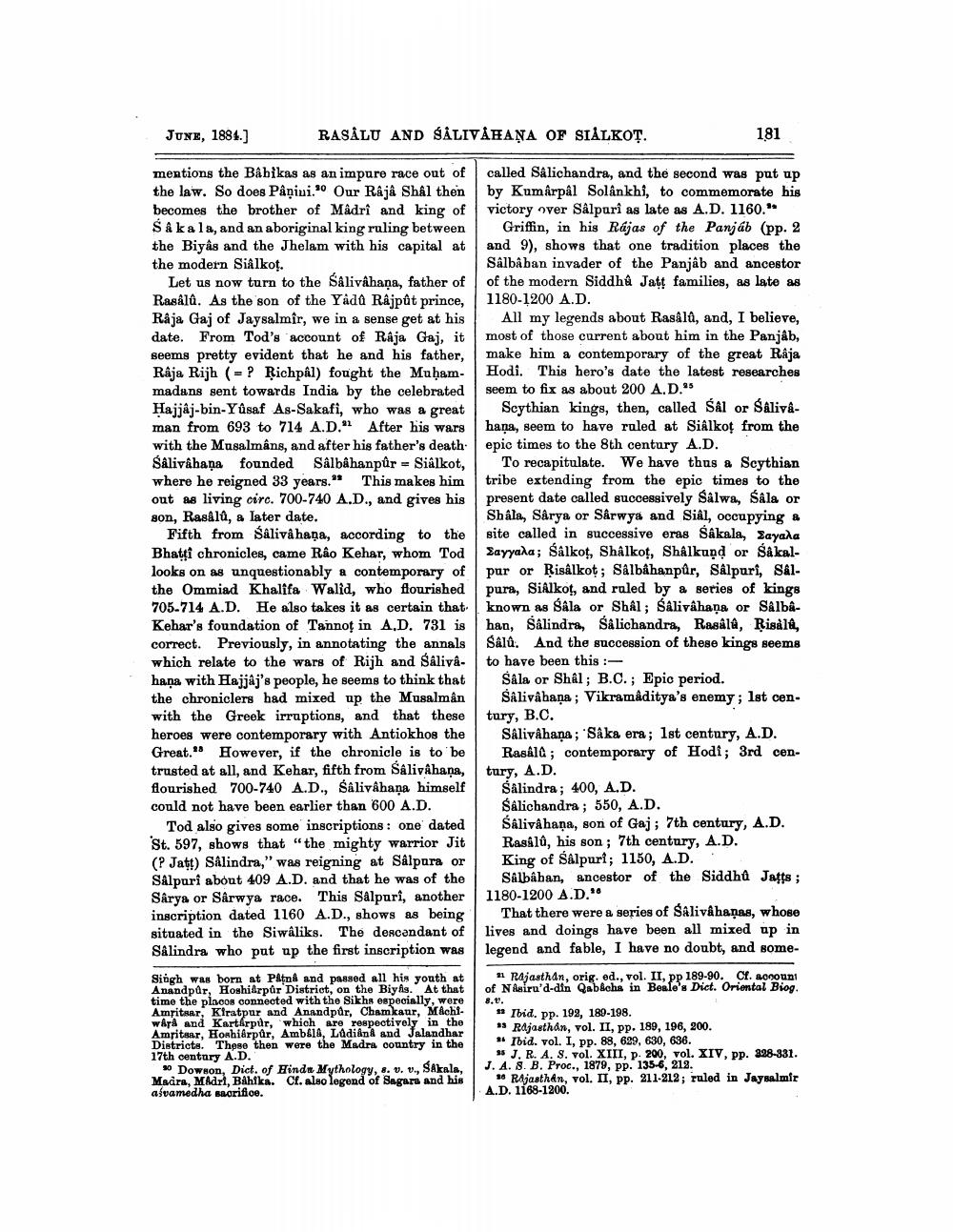________________
JUNE, 1884.]
RASALU AND SÅLIVÅHAŅA OF SIÅLKOT.
181
mentions the Bâbikas as an impure race out of called Salichandra, and the second was put up the law. So does Pâniui." Our Raja Shâl then by KumÁrpál Solánkhi, to commemorate his becomes the brother of Madri and king of victory over Sålpuri as late as A.D. 1160." Så kala, and an aboriginal king ruling between Griffin, in his Rájas of the Panjab (pp. 2 the Biyâs and the Jhelam with his capital at and 9), shows that one tradition places the the modern Sialkot.
Sâlbâban invader of the Panjab and ancestor Let us now turn to the Salivahaņa, father of of the modern Siddha Jatt families, as late as Rasálů. As the son of the Yada Rajput prince, 1180-1200 A.D. Raja Gaj of Jaysalmir, we in a sense get at his All my legends about Rasala, and, I believe, date. From Tod's account of Raja Gaj, it most of those current about him in the Panjab, seems pretty evident that he and his father, make him a contemporary of the great Raja Raja Rijh (= ? Richpål) fought the Muham- Hodi. This hero's date the latest researches madans sent towards India by the celebrated seem to fix as about 200 A.D." Hajjaj-bin-Yûsaf As-Sakafi, who was a great Scythian kings, then, called SAI or Salivaman from 693 to 714 A.D." After his wars hana, seem to have ruled at SiAlkot from the with the Musalmans, and after his father's death epic times to the 8th century A.D. Salivahaņa founded Sâlbâhanpur = Sialkot, To recapitulate. We have thus a Scythian where he reigned 33 years." This makes him tribe extending from the epic times to the out as living circ. 700-740 A.D., and gives his present date called successively Salwa, Sala or son, Rasálů, a later date.
Shala, Sârya or Sårwya and Siâl, occupying a Fifth from Salivå haņa, according to the site called in successive eras Sakala, Sayaha Bhatti chronicles, came Rao Kehar, whom Tod Sayyada; Salkot, Shâlkot, Shâlkund or Såkallooks on as unquestionably a contemporary of pur or ķisálkot; Salbahanpur, Sâlpuri, Sálthe Ommiad Khalifa Walid, who flourished pura, Sialkot, and ruled by a series of kings 705-714 A.D. He also takes it as certain that known as Sala or Shal; Salivahana or SalbaKehar's foundation of Tannot in A.D. 731 is han, Sálindra, Salichandra, Rasála, Risåld, correct. Previously, in annotating the annals Sâlû. And the succession of these kings seems which relate to the wars of Rijh and Saliya- to have been this :hana with Hajjaj's people, he seems to think that Sala or Shal; B.C.; Epic period. the chroniclers had mixed up the Musalman Salivahaņa ; Vikramaditya's enemy; 1st cen. with the Greek irruptions, and that these tury, B.C. heroes were contemporary with Antiokhos the Salivahana ; SAka era; 1st century, A.D. Great. However, if the chronicle is to be Rasald; contemporary of Hodi; 3rd centrusted at all, and Kehar, fifth from Salivahana, tury, A.D. flourished 700-740 A.D., Salivahaņa himself Salindra; 400, A.D. could not have been earlier than 600 A.D.
SAlichandra; 550, A.D. Tod also gives some inscriptions: one dated Salivá hana, son of Gaj; 7th century, A.D. St. 597, shows that “the mighty warrior Jit Rasklo, his son ; 7th century, A.D. (P Jatt) Sálindra," was reigning at Sâlpura or King of Salpuri; 1150, A.D. SAlpuri about 409 A.D. and that he was of the SAlbâban, ancestor of the Siddhů Jatts ; Sarya or SÅrwya race. This Salpuri, another | 1180-1200 A.D." inscription dated 1160 A.D., shows as being That there were a series of Salivahaņas, whose situated in the Siwâliks. The descendant of lives and doings have been all mixed up in Salindra who put up the first inscription was legend and fable, I have no doubt, and some
Singh was born at Patna and passed all his youth at Anandpur, Hoshiarpur District, on the BiyAs. At that time the plnoos connected with the Sikhs especially, were Amritsar, Kiratpur and Anandpur, Chamkaur, MAchiwar and Kartérpur, which are respectively in the Amritsar, Honhidrpur, Amb$14, Lúdián A and Jalandhar Districts. These then were the Madra country in the 17th century A.D.
90 Dowson, Dict. of Hindu Mythology, 8. v. v., Sakala, Madra, MAdri, Bahika. Cf. also legend of Sagara and his aśvamedha sacrifice.
11 Rajasthan, orig. ed., vol. II, pp 189-90. cf. account of N Asiru'd-din Qab&cha in Beale's Dict. Oriental Biog. 8.1.
# Ibid. pp. 192, 180-198. * Rajasthan, vol. II, pp. 189, 196, 200. ** Ibid. vol. I, pp. 88, 629, 630, 636.
SS J. R. A. 8. vol. XIII, p. 200, vol. XIV, pp. 328-331. J. A. 8. B. Proc., 1879, pp. 135-6, 212.
* Rajasthan, vol. II, pp. 211-212; ruled in Jaysalmir A.D. 1168-1200.




